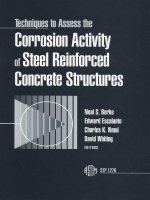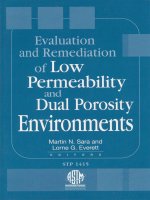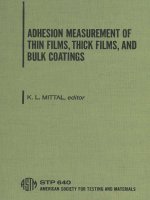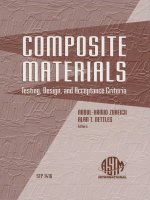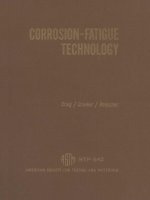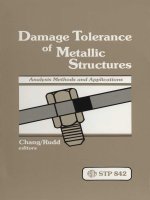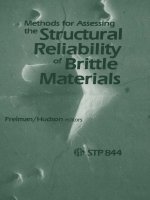Astm stp 637 1977
Bạn đang xem bản rút gọn của tài liệu. Xem và tải ngay bản đầy đủ của tài liệu tại đây (3.68 MB, 233 trang )
CYCLIC
STRESS-STRAIN AND
PLASTIC DEFORMATION
ASPECTS OF FATIGUE
CRACK GROWTH
A symposium
sponsored by ASTM
Committee E-9 on Fatigue
AMERICAN SOCIETY FOR
TESTING AND MATERIALS
St. Louis, Mo., 2-8 May 1976
ASTM SPECIAL TECHNICAL PUBLICATION 637
L. F. Impellizzeri, symposium chairman
List price $25.00
04-637000-30
AMERICAN SOCIETY FOR TESTING AND MATERIALS
1916 Race Street, Philadelphia, Pa. 19103
Copyright by ASTM Int'l (all rights reserved); Mon Dec 21 11:24:29 EST 2015
Downloaded/printed by
University of Washington (University of Washington) pursuant to License Agreement. No further reproductions authorized.
®BY AMERICAN SOCIETY FOR TESTING AND MATERIALS
1977
Library of Congress Catalog Card Number: 77-083428
NOTE
The Society is not responsible, as a body,
for the statements and opinions
advanced in this publication.
Printed in Tallahassee, Fla.
December 1977
Copyright by ASTM Int'l (all rights reserved); Mon Dec 21 11:24:29 EST 2015
Downloaded/printed by
University of Washington (University of Washington) pursuant to License Agreement. No further reproductions authorized
Foreword
The symposium on Cyclic Stress-Strain and Plastic Deformation Aspects
of Fatigue Crack Growth was presented at a meeting held in St. Louis, Mo.,
2-8 May 1976. The symposium was sponsored by the American Society for
Testing and Materials through its Committee E-9 on Fatigue. L. F. Impellizzeri, McDonnell Aircraft Company, presided as symposium chairman.
Copyright by ASTM Int'l (all rights reserved); Mon Dec 21 11:24:29 EST 2015
Downloaded/printed by
University of Washington (University of Washington) pursuant to License Agreement. No further reproductions authorized.
Related
ASTM Publications
Manual on Statistical Planning and Analysis for Fatigue Experiments,
STP 588 (1975), $15.00 (04-588000-30)
The Influence of State of Stress on Low-Cycle Fatigue of Structural Materials:
A Literature Survey and Interpretive Report, STP 549 (1974), $5.25
(04-549000-30)
Cyclic Stress-Strain Behavior—Analysis, Experimentation, and Failure
Prediction, STP 519 (1973), $28.00 (04-519000-30)
Copyright by ASTM Int'l (all rights reserved); Mon Dec 21 11:24:29 EST 2015
Downloaded/printed by
University of Washington (University of Washington) pursuant to License Agreement. No further reproductions authorized.
A Note of Appreciation
to Reviewers
This publication is made possible by the authors and, also, the unheralded efforts of the reviewers. This body of technical experts whose
dedication, sacrifice of time and effort, and collective wisdom in reviewing the papers must be acknowledged. The quality level of ASTM publications is a direct function of their respected opinions. On behalf of ASTM
we acknowledge with appreciation their contribution.
ASTM Committee on Publications
Copyright by ASTM Int'l (all rights reserved); Mon Dec 21 11:24:29 EST 2015
Downloaded/printed by
University of Washington (University of Washington) pursuant to License Agreement. No further reproductions authorized.
Editorial Staff
Jane B. Wheeler, Managing Editor
Helen M. Hoersch, Associate Editor
Ellen J. McGlinchey, Senior Assistant Editor
Kathleen P. Zirbser, Assistant Editor
Sheila G. Pulver, Assistant Editor
Copyright by ASTM Int'l (all rights reserved); Mon Dec 21 11:24:29 EST 2015
Downloaded/printed by
University of Washington (University of Washington) pursuant to License Agreement. No further reproductions authorized.
Contents
Introduction
The General Cyclic Stress-Strain Response of Aluminum Alloys—
CAMPBELL LAIRD
3
Behavior of Binary Alloys
Behavior of Complex Alloys
Cyclic Stress-Strain Response Under Variable-Amplitude Loading
Conclusions
Fatigue Crack Tip Plasticity—j.
6
9
23
32
LANKFORD, D. L. DAVIDSON, AND
T. S. COOK
36
Plastic Zone Size Calculations
Plastic Zone Size
Plastic Zone Shape
Conclusions
38
42
46
53
Finite-Element Analysis of Crack Growth Under Monotonic and
Cyclic Loading—J. c. NEWMAN, JR.
Methods of Analysis
Crack-Growth Criterion
Crack Growth Under Monotonic and Cyclic Loading
Concluding Remarks
Discussion
Analysis and Investigation of Small Flaws—A.
56
58
60
62
73
78
TALUG AND
K. REIFSNYDER
81
Analysis
Discussion of Results
Conclusions
84
86
92
Crack Growth During Low-Cycle Fatigue of Smooth Axial SpecimensN. E. DOWLING
97
Laboratory Investigation
Discussion
Conclusions and Recommendations
98
105
116
A Fatigue Crack Growth Analysis Method Based on a Simple Representation of Crack-Tip Plasticity—M. F. KANNINEN, C. ATKINSON,
AND C. E. FEDDERSON
122
Conceptual Basis of the Model
Analysis Procedure
Computational Results for Constant AK Load Cycles
Discussion and Comparison with Alternative Approaches
Conclusions
Copyright
Downloaded/printed
University
123
126
131
134
137
by
by
of
Analysis of Crack Growth Following Compressive High Loads Based
on Cracic Surface Displacements and Contact Analysis—
H. D. DILL AND C. R. SAFF
141
Crack Surface Displacement Analysis
Analysis of COD with Compressive Loads
Crack Growth Following Compressive High Loads
Effect of Cyclic Strain Hardening/Softening
Summary
142
146
147
151
152
Fatigue Analysis of Cold-Worked and Interference Fit Fastener HolesD. L. RICH AND L. F. IMPELLIZZERI
153
Fatigue Life: Crack Initiation Plus Crack Growth
Test Program
Analytical Techniques
Conclusions
154
156
158
174
Fatigue Crack Growth and Life Predictions in Man-Ten Steel Subjected
to Single and Intermittent Tensile Overloads—R. I. STEPHENS,
E. C. SHEETS, AND G. 0. NJUS
176
Material and Test Procedures
Test Resuhs
Mathematical Model
Discussion
Summary and Conclusions
Discussion
178
179
185
187
188
189
Load Interaction Effects on Fatigue Crack Growth in A514F Steel
A l l o y — W . J. MILLS, R. W. HERTZBERG, AND R. ROBERTS
192
Experimental Procedure
Presentation and Discussion of Results
Conclusions
194
195
206
Critical Remarks on the Validity of Fatigue Life Evaluation Methods
Based on Local Stress-Strain Behavior—D. SCHUTZ AND
J. J. GERHARZ
209
Life Prediction
Procedure
Results and Discussion
Conclusion
Copyright
Downloaded/printed
University
210
213
218
221
by
by
of
STP637-EB/Dec. 1977
Introduction
For many years, fatigue analysis simply meant finding the right applied
stress-cycles to failure (S-N) curve and using Miner's rule. When the importance of plastic deformation at stress concentrations became apparent,
analysis procedures and test techniques were developed to include the effects
of tensile and compressive residual stresses caused by local yielding and to
include strain hardening and softening and cyclic stress-strain hysteresis
effects in the fatigue computations. These procedures were used for what
could be termed crack initiation analysis. More recently, crack growth
analysis using continum mechanics' principles has emerged as an important
tool in designing fatigue- and fracture-resistant structures. The primary
objective of this symposium and publication was to focus attention on
efforts to combine the disciplines of cyclic stress-strain and plastic deformation analysis and fracture mechanics to further the understanding of
fatigue crack growth in structures.
In support of this objective, the following topics were addressed:
1. Cyclic stress-strain and plastic deformation in the region of growing
cracks.
2. Significance of material metallurgical characteristics.
3. Significance of variable-amplitude loading as compared to constant
amplitude loading.
4. Crack growth analysis methods including the effects of cyclic stressstrain and plastic deformation.
5. Percentage of total fatigue life that can be analyzed using the continuum
mechanics approach to crack growth analysis.
6. Combination of residual stress effects and fracture mechanics for
cracks originating at points of stress concentration.
This volume includes eleven papers discussing this list of topics from
various aspects that should be of use to designers and materials and structural scientists and engineers. It should not be considered a final treatise
but rather a contribution to the state of the art to stimulate thinking on
this important subject for research and design.
Copyright
by
Copyright 1977
Downloaded/printed
University
of
ASTM
Int'l
b y Aby
S T M International
Washington
(all
rights
reserved);
Mon
Dec
21
www.astm.org
(University
of
Washington)
pursuant
to
L
2
FATIGUE CRACK GROWTH
Grateful acknowledgment is given to the authors, the reviewers, and Jane
B. Wheeler and her staff.
L. F. Impellizzeri
Branch Chief, Technology-Strength,
McDonnell Aircraft Company,
St. Louis, Mo. 63166; symposium
chairman.
Copyright by ASTM Int'l (all rights reserved); Mon Dec 21 11:24:29 EST 2015
Downloaded/printed by
University of Washington (University of Washington) pursuant to License Agreement. No further reproductions authorized.
Campbell Laird ^
The General Cyclic Stress-Strain
Response of Aluminum Alloys
REFERENCE: Laird, Campbell, "The General Cyclic Stress-Strain Response of
Aluminum Alloys," Cyclic Stress-Strain and Plastic Deformation Aspects of Fatigue
Crack Growth, ASTM STP 637. American Society for Testing and Materials, 1977,
pp. 3-35.
ABSTRACT: The cyclic stress-strain response of a wide range of binary, ternary, and
complex commercial and experimental-commercial aluminum alloys has been investigated. In addition to constant-amplitude tests, incremental, block, random
loading tests, and other specialized tests have been used in assessing cyclic response.
The conditions under which cyclic hardening or softening occur have been elucidated,
and general conclusions have been drawn about cyclic response in aluminum alloys.
KEY WORDS: stresses, strains, stress cycle, deformation, hardening, softening,
aluminum alloys, loading, tests, particles, dispersions, fatigue, damage, fracturing,
crack propagation
When a metal or alloy is cycled through a constant- or varying-strain
amplitude, large changes normally occur in its flow stress; depending on the
metal and its processing history, hardening or softening may occur. Cyclic
stress-strain response (CSSR) is the term given to describe the relationships
between the flow stress and the cyclic strain, and it recently has been shown
to be useful both for understanding the fatigue process and as a phenomenon worth consideration in designing against fatigue. For examples, on the
basis of CSSR, Laird has supported the existence of a fatigue limit in most
metals and alloys, similar to that well accepted in steels [7],^ and Wetzel has
developed a new method of predicting damage under variable loading [2].
It is reasonable, then, to attempt in this publication to combine cyclic stressstrain response and fracture mechanics with the aim of an improved understanding of crack propagation.
One of the major unsolved problems in crack propagation is the understanding of the role of metallurgical factors in controlling crack, propaga'Chairman, Department of Metallurgy and Materials Science, University of Pennsylvania,
Philadelphia, Pa. 19174.
^The italic numbers in brackets refer to the list of references appended to this paper.
Copyright
by
Copyright 1977
Downloaded/printed
University
of
ASTM
Int'l
b y Aby
S T M International
Washington
(all
rights
reserved);
Mon
Dec
21
www.astm.org
(University
of
Washington)
pursuant
to
Lice
4
FATIGUE CRACK GROWTH
tion rates. Hahn and Simon [i] and Stoloff and Duquette [4] have reviewed
these factors in aluminum alloys recently and conclude:
1. Statically strong alloys, such as 7075-T6, can show higher growth
rates than less strong but more ductile alloys, such as 2024-T3.
2. Heat-to-heat variations in composition and processing, small amounts
of cold work, and different heat treatments can alter the life of a typical
alloy such as 2024-T3 by as much as 100 percent.
3. Brittle fracture modes associated with inclusions or intermetallic particles can double the rate of crack propagation when the advance per cycle
is large (~1 /xm/cycle).
These variations are not understood in detail, and it is worthwhile to explore whether CSSR, by describing the behavior of the material at a crack
tip, may yield their explanation. If in fact the combination of CSSR and
fracture mechanics can solve this problem and related problems such as
crack propagation rates under variable loading, it is necessary that we have
a firm understanding of CSSR in relation to microstructure.^ One aim of
this paper is to explore our present state of knowledge. However, a secondary aim is explained and justified in the following paragraphs.
It often happens that a metal or alloy subject to cyclic strains will harden
rapidly in the first few applications of strain, but the hardening rate decreases with accumulating strains and eventually reaches zero, at which
point the material is described as being "stable" or in "saturation." A common goal of cyclic hardening studies is to measure the cyclic stress-strain
curve associated with this condition, defined as the curve formed by connecting the tips of stable hysteresis loops from constant-amplitude, straincontrolled fatigue tests of several specimens cycled at different strain ranges.
Because the cyclic stress-strain curve (CSSC) is useful, engineers have documented it by several methods and for many metals. One special object of
study has been developing alternative procedures for determining the CSSC.
It was found, for example, that the incremental step test (see Fig. 1 for
description) provides a useful method of measuring the CSSR of several
metals at room temperature [5]. It is interesting, but perhaps not surprising,
that such tests yielded essentially equivalent responses to that of constantamplitude tests because the metals tested were wavy in slip mode [6], and it
is known that metals of this type show history-independent cyclic response
in most circumstances [7]. Metals of planar slip behavior can be expected
to yield more complex results in incremental step tests, since they show a
strong history dependence in their cyclic response [5]. In confirmation of
this, Jaske et al, who studied Ni-Fe-Cr Alloy 800 and Type 304 stainless
steel [8], found that, even at high temperature,' the results of incremental
^The "microstructure" treated here is assumed to be uniform through the material and thus
does not encompass macrostructural variations caused by processing difficulties such as
segregation during solidification, incomplete recrystallization during solid state processing,
and so forth. These macrovariations must be important in cyclic response and fatigue fracture,
and more work is required for their study.
Copyright by ASTM Int'l (all rights reserved); Mon Dec 21 11:24:29 EST 2015
Downloaded/printed by
University of Washington (University of Washington) pursuant to License Agreement. No further reproductions authorize
LAIRD ON ALUMINUM ALLOYS
5
(a)
o
(b)
-J
s
(c)
(d)
TIME
FIG. 1 —Methods of testing: (a) incremental test, (b) multiple-step (or block) test, (c) randomloading test, and (d) a test designed to simulate in a regular specimen the strain history experienced by a ligament of material in the path of an advancing crack—namely, an incremental
test to simulate the saturation condition followed by a gradually increasing cyclic-strain amplitude to fracture. The block test is controlled by plastic strain, the others by total strain.
Step tests were significantly different from those of constant-amplitude
tests; the cycles applied at high strains in the incremental steps establish a
structure which influences the subsequent cycles at low strain and causes
their stress amplitudes to be higher than those observed in constant-amplitude tests.
Because CSSCs now are being applied more widely and successfully in
the prediction of cumulative fatigue damage [2,9], it is important to know
whether or not the CSSCs obtained under complex strain histories are the
same as those under constant-strain amplitudes. In many steels and certain
commercial aluminum alloys, it appears that they are the same [2], but
Koibuchi and Kotani have obtained a slightly different result [10]. Working
with a low-carbon steel, these investigators found that the cyclic stressstrain curve from constant-amplitude tests (or equivalently, from a block
test; see Fig. \b) is somewhat different from that of the incremental step
tests; however, that from a random-loading test is essentially identical to
that of the incremental step test [10]. It would appear, therefore, that an
economical method of studying this question would be to compare results
from incremental step tests with those of constant-amplitude tests, provided
checks with random tests are also made, and confidence in reproducibility
is established.
In spite of the many engineering investigations which have been carried
Copyright by ASTM Int'l (all rights reserved); Mon Dec 21 11:24:29 EST 2015
Downloaded/printed by
University of Washington (University of Washington) pursuant to License Agreement. No further reproductions authorized
6
FATIGUE CRACK GROWTH
out on commercial materials and many fundamental studies of materials
cycled under constant-strain amplitudes, no fundamental studies, from the
viewpoint of a material scientist, have been made to evaluate response
under complex varying strains. The present investigation was undertaken
with the subsidiary aim of rectifying this matter.
Behavior of Binary Alloys
In spite of the relatively few investigations of CSSR which have been
made of binary aluminum alloys [77-76], the broad outlines of their behavior have been established as follows. When the hardening particles
are small and so closely spaced that the dislocations are required by an
applied cyclic plastic strain to pass through them because the interparticle
bowing stress is too high for the dislocations to do otherwise, then considerable work hardening is caused by the first cycles of strain. Typical precipitates associated with this behavior are Guinier-Preston (GP) zones or,
for example, in aluminum-copper alloys, 6" plates. As shown in Fig. 2, hardening eventually reaches a peak, and cyclic softening subsequently occurs [12].
In a polycrystal, the hardening is associated with the redistribution of
strain in the material. In the first few cycles, the grains optimally oriented
for slip with respect to the stress axis show the strongest sHp markings,
300
-200
-100
NUMBER OF REVERSALS
FIG. 2—Cyclic response curves for an Al-4 Cu alloy containing 6" particles, showing hardening to a peak stress and then gradual softening until fracture (marked with a cross). The
ordinate shows the stress amplitude averagedfrom succeeding tensile and compressive reversals,
and the strains indicated are constant-plastic-strain amplitudes. Courtesy of Calabrese and
Laird [\2].
••In this paper, data points are not shown on cyclic hardening or softening curves because
they are so numerous that, on the scale of the plot, the curves consist of a continuous string
of points.
Copyright by ASTM Int'l (all rights reserved); Mon Dec 21 11:24:29 EST 2015
Downloaded/printed by
University of Washington (University of Washington) pursuant to License Agreement. No further reproductions authorized
LAIRD ON ALUMINUM ALLOYS
7
and, as they work harden, adjoining grains of "harder" orientation become
more marked with slip bands. Dislocations are stored uniformly in tangled
masses throughout the grains, but dense dislocation bands, slightly misoriented with respect to the grains which contain them, also form and
become more numerous until peak hardening is attained. With continued
cycling, the dislocation bands become more intense, and it is clear that the
bulk of the strain is carried by them. This localization of strain is believed
[72] to be associated with the softening which occupies the largest fraction
of the life (Fig. 2). Calabrese and Laird investigated this softening in the
light of mechanisms previously advanced to explain the poor fatigue properties of strong alloys (the endurance limit being small in relation to ultimate tensile strength [72]), namely: overaging, precipitate reversion, precipitate fracture, and aging inhomogeneities [77-2i]. They concluded that
none of these was appropriate to aluminum-copper and offered, instead, an
explanation of softening based on the following argument, closely akin to
one previously discussed by Byrne et al [24] with respect to unidirectional
deformation in this type of alloy. Since the dislocations in the active bands
are highly jogged and ragged and are continually interacting, their to-andfro motion generally takes an irreproducible path. Therefore, the to-andfro motions of dislocations through different paths cause a mechanical
scrambhng of the atoms in the precipitates, that is, their general structure
becomes disordered, and the probability of a cutting dislocation creating
different atom pairs is reduced. Softening then results from the loss of the
interface steps and ordering contributions to hardening, and it is likely that
the elastic properties of the precipitates are affected adversely also.
The CSSR of binary aluminum alloys is completely different from that
just mentioned when the hardening particles are large and sufficiently
widely spaced for the dislocations to pass between them in Orowan's fashion.
As shown in Fig. 3, for such a microstructure, the hardening which occurs
at the start of cycling is exhausted quickly, and the material becomes extremely stable. The slip is distributed homogeneously, and all the large plate
precipitates are densely packed with dislocations [13]. Calabrese and Laird
[75] used Ashby's model of "geometrically necessary" dislocations [25] to
interpret such behavior. In this model, the plates are assumed not to deform,
and to be strongly bonded to the matrix. If the microstructure is sheared
as a whole, the matrix close to the plates cannot shear and must rotate,
requiring geometrically necessary dislocations to be stored at the platematrix interfaces. The production of such dislocations leads to hardening.
As the strain is cycled, the geometrically necessary dislocations are shuttled
between plates on the same habit planes, and the hardening is therefore
very stable. In addition, the strain distribution in the specimen is highly
uniform [13].
Fine and Santner [75] have explored the CSSR of binary aluminumcopper alloy in which the microstructure was manipulated so as to contain the
types of precipitates reported previously. In one alloy, Al-3.6Cu, used as a
Copyright by ASTM Int'l (all rights reserved); Mon Dec 21 11:24:29 EST 2015
Downloaded/printed by
University of Washington (University of Washington) pursuant to License Agreement. No further reproductions authorized.
8
FATIGUE CRACK GROWTH
40
35
1
A[-4%Cu
30
y^
1
1
1
1
1
Al-4%C ,2%e-250°C/3HR
^
0.010
^
Z'
0.0050
^
0.0025
^
0.0050
/ -
1
250°C/5HR
0010
CO 2 5 - ^
a 20
1
^
V
00025
"*
X
0.00035
I-
•>*"
0.00035
I5|-
10
b
a
5
1
1
1
10
10^
lO'^
1
1
lO"*
1
10
REVERSALS
1
1
1
10'=
lO'^
10"
10=
FIG. 3—Cyclic hardening curves for AI-4 Cu alloy aged at 250° C for 5 h so as to produce a
uniform dispersion of large 8' plates. Cold-working reduces the 6' plate spacing and raises the
flow stress.
control, the microstructure contained Guinier-Preston I (GPI) zones only. In
another, containing 6.3Cu, undissolved, equiaxed 6 particles 5 to 10 fim in
diameter were distributed in a matrix, containing GPI zones. As shown in
Fig. 4, the aluminum alloy containing GPI zones only first hardened and
subsequently softened just like the alloy studied by Calabrese and Laird
[12]. The Al-6.3Cu alloy hardened and subsequently softened only at large
and intermediate strains. However, at low strains, softening was not observed.^ The interpretation is that, at high strains, the GPI zones were cut
sufficiently to disorder the structure and the alloy softened. At low strains,
the large 6 particles homogenized the strain and thus prevented the localization of the strain required to soften the structure in the active bands. Also
shown in Fig. 4 are cyclic hardening curves for 2024-T4. Consistent with
the work of Endo and Morrow [26], no softening was observed [16]. Commercial alloys contain more inclusions and dispersed phases than binary A16.3Cu alloy aiid can be expected, therefore, to be more effective in multiplying dislocations and in homogenizing the strain. The role of these particles in cyclic deformation is given extended treatment in the following
section.
'It is possible that, at really low strains, where lives are greater than lO* cycles, strain localization may occur on a scale smaller than that of the inter-© spacing, in which case, softening
might very well occur.
Copyright by ASTM Int'l (all rights reserved); Mon Dec 21 11:24:29 EST 2015
Downloaded/printed by
University of Washington (University of Washington) pursuant to License Agreement. No further reproductions authorized
LAIRD ON ALUMINUM ALLOYS
9
Behavior of Complex Alloys
Experimental Details
Since aluminum-zinc-magnesium alloys have not been studied as extensively as commercial alloys more closely related to binary aluminum-copper,
aluminum-zinc-magnesium has been chosen for study here. Another reason
for the choice relates to the rather poor crack propagation behavior shown
by these alloys as compared to that of 2024 and related alloys [i]. The variables selected in this study of CSSR are: (a) types of dispersed phases, {b)
initial dislocation content of the material in relation to the hardening particles and (c) the nature of the loading (Fig. 1). A discussion of the nature of
the dispersed phases which commonly occur in commercial aluminum alloys
is necessary in order to clarify the specific choices of material. The literature
FIG. 4—Cyclic response curves for the aluminum alloys indicated, during plastic-straincontrolled cycling. The peak stress refers to the stress amplitude at the tensile reversal. Courtesy
of Fine and Santner [16].
Copyright by ASTM Int'l (all rights reserved); Mon Dec 21 11:24:29 EST 2015
Downloaded/printed by
University of Washington (University of Washington) pursuant to License Agreement. No further reproductions authoriz
10
FATIGUE CRACK GROWTH
which deals with these phases is extensive, but a good reference which explains the role of the particles in fracture can be found in the review article
by Kaufman [27].
The largest particles in aluminum alloys are termed the constituent particles. They are generally greater than 1 /xm in diameter and form by eutectic
decomposition during ingot solidification. Since they consist of insoluble
particles such as Al7Cu2Fe, Mg2Si, or (Fe, Mn) Al^, they cannot be taken
into solid solution during fabrication. Sometimes, the relatively soluble
CuAl2 or CuAl2Mg also occur as constituent particles. A second grouping
of particles (in the 0.03 to 0.5 /um range), called dispersoids, consist of
Ali2Mg2Cr or Al2oCu2Mn formed by solid-state precipitation, and is also
difficult to dissolve. During fabrication, these particles suppress recrystallization and hmit the growth of grains. The third and finest set of particles
consists of the age-hardening precipitates of major alloying elements, GP
zones, which impede dislocation motion, and lead to the optimum combinations of strength and toughness.
It is apparent from the chemistry of the particles that the best way of
eliminating the constituent particles (which fracture easily in unidirectional deformation and also in fatigue [27] is to reduce the iron and silicon
content of the alloy. The control of the dispersoids is more difficult; one
means of reducing their volume fraction is by eliminating chromium, but
this makes certain stages of the processing, particularly grain control,
difficuh. Accordingly, the alloys* listed in Table 1 along with their compositions and heat treatments have been selected as a compromise for the
following reasons, (a) Conventionally processed 7075-T651 is useful as a
basis for comparison with previous investigations; it is supplied in the
form of 2-in.-thick plate to permit tests in the short transverse direction, (b)
"High-purity" 7075-T651, conventionally processed, is low in iron and
silicon, and therefore free of constituent particles; otherwise, it is similar
in all respects to conventional 7075 (no differences could be detected between the alloys at the high magnification of the electron microscope).
It also was supplied in the form of 2-in.-thick plate. This alloy permits the
role of the constituent particles in CSSR to be discriminated from that of
the dispersoids. (c) Conventionally processed, high-purity 7075 given a
final thermomechanical treatment (FTMT) so as to introduce dislocations
into the microstructure, and to modify the hardening precipitates which are
known to nucleate heterogeneously on the dislocations was used. This
material was supplied as I-in. plate, (cf) A conventional, pure aluminumzinc-magnesium ternary free of both constituent particles and dispersoids
and artificially and naturally aged to develop GP zones containing both
solutes. The details of the GP zone structure in this alloy are unknown;
'The commercial-type alloys were kindly supplied by J. Waldman and H. Sulinski of Frankford Arsenal, Philadelphia. Full details of their processing, mechanical properties, and microstructures can be found in Refs 28, 29.
Copyright by ASTM Int'l (all rights reserved); Mon Dec 21 11:24:29 EST 2015
Downloaded/printed by
University of Washington (University of Washington) pursuant to License Agreement. No further reproductions authorized.
LAIRD O N A L U M I N U M ALLOYS
m
.
11
o
3
V
E
I
Đ
3
C
ãĐ
3
in
Đ
<
^
Đ
a.
o
o
U
e
3
o
o
Đ
Đ
o
d
o
SLxT
ôN
^
00
2-CJ
ãQ
00
-
ão2
00 T 3
ôa,
c
N
c
H
so Tf
H (-
,U
o
If
3
i
ão
U
00
<
00
^
6 g "
o o
O r4
O^ 00
•a -o
2. S
•a a
00 U
c a ''^ c
o'
U
.•ao
i. "^
00 p:
e-^
oI SJ
3 '3 J< 3
IZI [/3 ^
1/3 i n ^
Copyright by ASTM Int'l (all rights reserved); Mon Dec 21 11:24:29 EST 2015
Downloaded/printed by
University of Washington (University of Washington) pursuant to License Agreement. No further reproductions author
12
FATIGUE CRACK GROWTH
however, since the succeeding metastable phases are known to be ordered,
the GP zone structure should be a good candidate to undergo cyclic
softening by structural disordering. This material was suppHed as 3/4-in.
(19.1-mm) rod. In addition, an Al-15Ag alloy was vacuum cast, homogenized, swaged, solution treated at 550° C for 4 h and cold water quenched,
swaged again, and solution treated for 2 min in order to recrystallize the
structure; it was finally given a 15 percent reduction by swaging to introduce dislocations for heterogeneous precipitation of the hexagonal 7'
precipitate [30,31] on subsequent aging, and finally aged at 160°C for
1V2 h. The purpose of choosing this alloy and the particular heat treatment
adopted was to check whether or not cyclic softening would occur in a
material where the dislocations are heavily decorated by precipitation, and
it should yield an interesting comparison with respect to the complex 7075
alloy with FTMT.
The monotonic properties of these materials are shown in Table 2. Consistent with the differing compositions, the strengths of the conventional
and high-purity 7075 are roughly equal, but the ductility of the latter is
improved greatly, especially in the long and short transverse directions.
The high-purity 7075-FTMT is the strongest of the alloys listed, but its
ductility is still high relative to that of the conventional 7075.
Cyclic deformation tests were carried out by all the loading modes shown
in Fig. 1, in addition to tests under constant-plastic-strain amplitude on
most of the materials Usted. Only selected data required to establish the
main points of the CSSR of aluminum alloys are reported here, however.
The specimens had threaded ends and usually had a gage section of 0.5 in.
(12.7 mm) length and 0.25 in, (6.35 mm) diameter, except for conventional
and high-purity 7075 tested in the short transverse direction, in which the
specimens had a gage length of 0.2 in. (5.08 mm) and diameter 0.15 in. (3.81 mm).
The specimens were electropolished prior to testing, which was carried out
by closed-loop, electrohydrauUc, computer-controlled equipment, using
standard clip-on gages for strain control.
Cyclic Stress-Strain Response—Constant Plastic Strain Amplitude
Cyclic hardening and softening curves for three of the materials studied
are shown in Fig. 5. Both the conventional 7075 (high-purity 7075 was
similar) and the aluminum-zinc-magnesium ternary alloys showed regular
hardening behavior, the latter consistent with the work of Sanders [32],
for the strain amplitudes indicated. The 7075 FTMT showed very high
cyclic flow stresses on account of its high strength but was subject to cyclic
softening. Presumably, many of the dislocations introduced by the final
deformation were pinned inadequately by the final precipitation and thus
were capable of rearrangement. The CSSCs of conventional and highpurity 7075 are shown in Fig 6a, which includes measurements for specimens cut from the longitudinal and long and short transverse directions of
the material. Two useful conclusions emerge from this figure: (a) the CSSR
Copyright by ASTM Int'l (all rights reserved); Mon Dec 21 11:24:29 EST 2015
Downloaded/printed by
University of Washington (University of Washington) pursuant to License Agreement. No further reproductions authorized.
LAIRD ON ALUMINUM ALLOYS
.c ^
c S
u
a: s2
u
3
•o
u
.
. r^ Ov o o» r^
• r-' ^d vd ^ 00
.
<
13
>
/^ o
o6
^
(N
^2 u
ll
m r*^
rn —"
ON r - i
OS
O
^o
ON
( N
t^ (^ m 00 m
» r i i n
o ^ —
••
t^ r^
r*^ f*^
^
> M
00
m
o so
•
^
• ^
o
r
• ^
OS
fN
oo
OS
w->
(N
Tf
vS
oo
fS
00
oi
OS
fS
OS
r4
oo oo r-
'O
o0 0
w-i
»rl
-^
so
o
[^
o o r~ — \o os
«0 «0 Tt
C —
ir 00
—oo
a\
O^
CM T t
o
OS
Ov'
«ri f s —
rsi
r^ oo r^ '^'
(^ so
OS
'^
in
—
OS so
00 00
so
£^
X
dr t
u c
-
• — '
1
ằ fe
r-r*^
(N
-Ci
ãc
oo
rn
in
o T;
^B
c.S
so
d
fô^
- . ^ ã ^
gig
_U sO
^
* i 'Ct
V
c
.2 ^ u
6
.2
•5
c
eS - ^ CO
g.ss:
c
3 C 3 c
- _
d
-o
rt
£
£
e £o^
a
c e
1 ^
00
(S
C- &
-S
OS
<
lllli 11
ffl
um
{fl
O
in
00
d <
(« <
Ml
SI
BO
z
o
3
is
u
I
5
E<
ii
Copyright by ASTM Int'l (all rights reserved); Mon Dec 21 11:24:29 EST 2015
Downloaded/printed by
University of Washington (University of Washington) pursuant to License Agreement. No further reproductions authorized.
14
FATIGUE CRACK GROWTH
90
' I'M
1—I I I I I 11
001
1
1—I I I I n I
CONVENTIONAL
"" O005
Q003
1
1—r-n
7075-T65I
550
OOOI
480
HIGH PURITY " 7 0 7 5 " - FTMT
620
550 Q.
Al-Zn-Mg
00025
I35C/24HRS
400
300
lO"*
FIG. 5—Cyclic response curves for (a) conventional 7075-T651, (b) high-purity 7075-FTMT,
and (c) Al-Zn-Mg, peak strength. The constant-plastic-strain amplitudes for each specimen are
indicated, and rapid declines in stress amplitude near the ends of life are all associated with
propagation of a large crack.
of conventional and high-purity 7075 are essentially similar, and this shows
that the dispersoids, rather than the constituent particles, play the dominant
role in improving the CSSR of commercial alloys with respect to the base
alloy; (Jb) there is no significant difference in the CSSCs of the specimens
cut from the different directions of the material. However, the fatigue
lives of the alloys do vary significantly with direction, specimens cut in the
short transverse direction showing lives (in a Coffm-Manson plot) one
quarter of those in the longitudinal direction for the conventional 7075
alloy. However, the high-purity 7075 alloy showed no significant effect of
processing direction on fatigue life. This means that the CSSR is necessary
to describe the fracture rate because it may well control the degree of blunting at the crack tip. However, it will not be sufficient to explain the entire
kinetics of crack propagation because static failure mechanisms can be expected to accelerate the rate. Detailed crack propagation studies will have
to be carried out to determine the other parameters necessary to describe
the kinetics completely.
The e s s e for the aluminum-zinc-magnesium alloy (Fig. db) is interesting
in that the scatter (maximum ~2 percent) is less than that of the 7075 alloys
(~5 percent) and the flow stress much less because of the lower volume
fraction of all types of strengthening particles. The difference in scatter
can be attributed to the greater difficulty of producing a homogeneous
microstructure in a complex alloy. Also shown in Fig. 6b is the cyclic stress-
Copyright by ASTM Int'l (all rights reserved); Mon Dec 21 11:24:29 EST 2015
Downloaded/printed by
University of Washington (University of Washington) pursuant to License Agreement. No further reproductions authorized.
LAIRD ON ALUMINUM ALLOYS
15
90
600
80
Q.
S
500
70
HIGH P U R I T Y
3
7075-T65I
LONGITUDINAL
O
LONG T R A N S V E R S E
a
SHORT T R A N S V E R S E
i
400
60
50
COMMERCIAL
^
300
PURITY
7075-T65I
LONGITUDINAL
LONG T R A N S V E R S E
SHORT T R A N S V E R S E
I-
•
•
*
40
30
200
10
PLASTIC
I
"1
STRAIN
I
Al-Zn-Mg
1
AMPLITUDE
20
x 10
70
1
l35C/24hr
450
ã
60
,o-^s-
400
.A^'
'/'
I
or
ô
350
a CONSTANT STRAIN AMPLITUDE
o
BLOCK
ã
RAMPED INCREMENTAL TEST
50
TEST
300
40
250
PLASTIC
S T R A I N AMPLITUDE
x 10"
FIG. 6—Cyclic stress-strain curves for: (a) conventional and high-purity 7075-T651, specimens cut parallel and perpendicular to the rolling direction, (b) Al-Zn-Mg ternary alloy.
Strain behavior associated with the testing mode shown in Fig. Id, which
might be termed the "ramped-incremental test." This shows that the CSSC
is a reasonable approximation for the cyclic deformation behavior of
material at a crack tip and can be extrapolated to rather high strains with
confidence. In fact, the ramp could not be increased much beyond 5 percent
Copyright by ASTM Int'l (all rights reserved); Mon Dec 21 11:24:29 EST 2015
Downloaded/printed by
University of Washington (University of Washington) pursuant to License Agreement. No further reproductions authorized.
16
FATIGUE CRACK GROWTH
because the specimens began to buckle; however, the rate of hardening
for these materials is becoming quite small at such large strains, and this is
the main justification for extrapolation to the still higher strains which
would occur at a crack tip.
Cyclic Response at Intermediate Strains
The most unexpected result is that the aluminum-zinc-magnesium ternary
does not show cyclic softening down to plastic-strain amplitudes of 0.00025.
Transmission electron microscopy of the cycled structures showed that the dislocations were arranged uniformly (Fig. 7a). However, dislocation banding
was observed occasionally (Fig. Tb). Since such banding previously has been
associated with softening [12], typical bands were explored carefully.
Their dark contrast was always associated with slight crystal reorientation,
which in Fig. 7b had tilted the crystal locally nearer to the Bragg condition.
The dislocation densities in the bands were not significantly different,
however, from those of the matrix. It would appear then that the deformation is too widespread to permit structural disordering and softening.
To check this interpretation, attempts were made to strain cycle specimens at still lower strains. However, closed-loop control on the plastic
strain, a very small part of the total strain measured by the transducer,
was found to be difficult, and it was decided, therefore, to do load-cycling
experiments instead. A typical result for a naturally aged specimen is shown
in Fig. 8. Consistent with the fairly low yield stress of this material, rather
large strains were observed on application of the first few cycles. However,
the material work hardened considerably; the plastic strain was reduced considerably by the 50th cycle, and it lay in the microstrain region by the 300th.
It subsequently remained there for several thousands of cycles; however,
by the 10 000th cycle, the hysteresis loop had widened appreciably, and it
continued to widen long before the propagation of a significant crack.
Increase of plastic strain under constant-stress cycling is an indicator of
cyclic softening; it could also be an indicator that small cracks had nucleated
and were showing plastic strain in association with their stress concentrations. To discriminate between these possibilities, two kinds of experiment were carried out: (a) fractography, in order to find out the point in
life at which the important cracks had formed, and (b) a cycling experiment
where cracks were introduced deliberately by nicking the surface of the
gage length with a razor blade. Typical fractographs are shown in Figs. 9
and 10. Since the specimen of which the CSSR is shown in Fig. 8 failed by
intergranular fracture, the fracture surface showed very little evidence of
striations. However, the fracture surface features shown in Fig. 9 near the
two nucleation sites shown (there were seven in all) were rather coarse,
which indicate that the cracks started very late in the life. This is supported by
fractographic observations (Fig. 10) of a specimen aged at 135°C/24 h.
and cycled at the same stress, which lasted for about the same number of
Copyright by ASTM Int'l (all rights reserved); Mon Dec 21 11:24:29 EST 2015
Downloaded/printed by
University of Washington (University of Washington) pursuant to License Agreement. No further reproductions authorized



